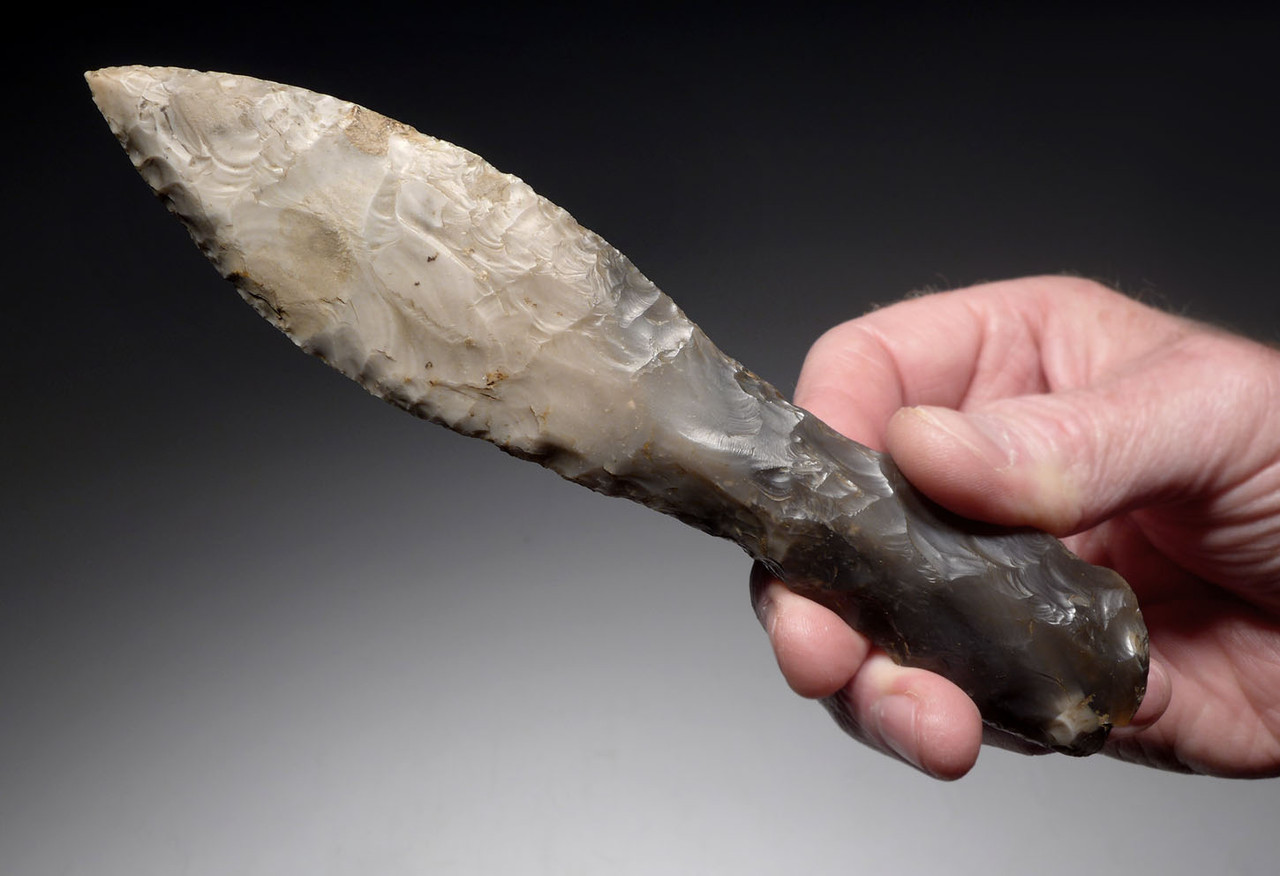Product Description
SEE MORE EUROPEAN NEOLITHIC ARTIFACTS
SEE MORE EUROPEAN BRONZE AGE ARTIFACTS
This genuine Late Neolithic Type II flint bifacial dagger with integral handle, is a very rare offering of an exceptional PRESTIGE WEAPON of Scandinavian Europe. It comes from the Late Neolithic Corded Ware culture and was found in Denmark. Late Neolithic flint daggers are considered the HOLY GRAIL artifact of Europe's New Stone Age Period and with many fakes floating around the market for the past century, authentic, undamaged, complete and well-made specimens continue to sky-rocket in price due to buyer demand, worldwide. This is a spectacular example of a TYPE II form, the predecessor of the later fish-tail daggers, and other elaborately made types. It is certain, based on their rarity and work spent in flaking them in antiquity, that these were the PRIMARY luxury possession of every European Neolithic warrior. Their importance and pride of ownership over 4000 years ago is still the same today. The famous Late Neolithic flint daggers are considered the primary masterpieces of the era in Europe, and were the most coveted prestige item of Europe's Neolithic warriors.
Seen on this INVESTMENT-GRADE example is a complete, integral handle to the perfect leaf-shaped blade but with a special artistic feature purposefully imparted by its original maker - a lighter-colored portion of the flint was oriented to fall on the blade. This gives a surreal look of the blade glowing compared to its darker contrasting handle! The blade edge and tip are complete as made with incredible pressure flaking all up the cutting edge ON BOTH SIDES. The tip is PERFECT AND POINTED AS ORIGINALLY MADE WITH NO MODERN DAMAGE! European flint Neolithic daggers of this quality are nearly impossible to find today on the market outside of small private sales in Europe.
Because of the insatiable demand of these Late Neolithic European flint daggers, that has existed for over 100 years, very convincing fakes ARE A MAJOR PROBLEM and no purchase should ever be made without a WRITTEN LIFETIME, UNCONDITIONAL GUARANTEE OF AUTHENTICITY AND CONDITION. Having operated our own lab and working now for nearly 40 years in the field of prehistoric and ancient lithics has afforded us the ability to absolutely identify fakes and altered specimens. This specimen has ancient deposits and minerals in all the hinge fractures and micro-crevices - proof-positive of this example being 100% authentic with NO ALTERATIONS, RESTORATION OR REPAIR.
Complete and intact as originally made, with ancient mineral deposits and no evidence of any alteration or modern flaking testifying to its authenticity and supreme preservation.
Following this period in time, these daggers would be replaced with copper, and then bronze examples.
HISTORY
The Corded Ware culture comprises a broad archaeological horizon of Europe between ca. 2900 BCE – 2350 BCE, thus from the late Neolithic, through the Copper Age, and ending in the early Bronze Age. The Corded Ware culture encompassed a vast area, from the contact zone between the Yamnaya culture and the Corded ware culture in south Central Europe, to the Rhine on the west and the Volga in the east, occupying parts of Northern Europe, Central Europe and Eastern Europe. The term Corded Ware culture is named after the cord-like impressions or ornamentation characteristic of its pottery.
Corded Ware encompassed most of continental northern Europe from the Rhine on the west to the Volga in the east, including most of modern-day Germany, the Netherlands, Denmark, Poland, Lithuania, Latvia, Estonia, Belarus, Czech Republic, Austria, Hungary, Slovakia, Switzerland, northwestern Romania, northern Ukraine, and the European part of Russia, as well as coastal Norway and the southern portions of Sweden and Finland. In the Late Eneolithic / Early Bronze Age, it encompassed the territory of nearly the entire Balkan Peninsula, where Corded Ware mixed with other steppe elements.
Archaeologists note that Corded Ware was not a "unified culture," as Corded Ware groups inhabiting a vast geographical area from the Rhine to Volga seem to have regionally specific subsistence strategies and economies. This culture included the Battle Axe culture and the Single Grave culture. There are differences in the material culture and in settlements and society. At the same time, they had several shared elements that are characteristic of all Corded Ware groups, such as their burial practices, pottery with "cord" decoration and unique stone-axes.
 US DOLLAR
US DOLLAR
 EURO
EURO
 AUSTRALIAN DOLLAR
AUSTRALIAN DOLLAR
 CANADIAN DOLLAR
CANADIAN DOLLAR
 POUND STERLING
POUND STERLING




































